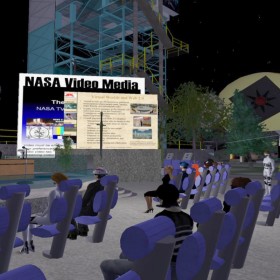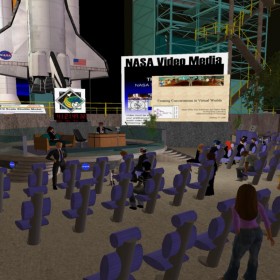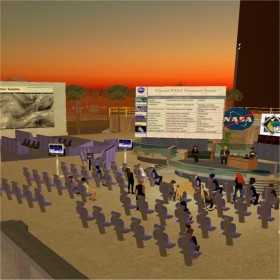NASA-Ontolog-KMWG OKMDS mini-series Session-03 - Thu 17-January-2008 (16I2)
- Subject: Ontology in Knowledge Management and Decision Support (OKMDS): Making Better Decisions (177Z)
- Panel Session Title: Creating Informational and Virtual Space for Knowledge Sharing (1780)
- Session chair: Ms. Jeanne Holm (NASA/JPL) (1781)
- Panelists: TomSoderstrom (NASA/JPL), JeanneHolm (NASA/JPL) and MarcelaOliva (LATTC Architecture, LACCD Facilities K.M.) (1782)
- Archive: slides: 1-Soderstrom, 2-Holm, 3-Oliva & audio recording of the session (mp3) (1783)
- Location in Second Life: Explorer Island - http://slurl.com/secondlife/Explorer%20Island/198/208/22 (178M)
 .
.  .
.  (19T6)
(19T6)
From the SL virtual world event: screenshot-01 screenshot-02 screenshot-03 (click on above links to view the full size images) . . . . . . (17EH)
Conference Call Details (1784)
- Date: Thursday, January 17, 2008 (1785)
- Start Time: 10:30am PST / 1:30pm EST / 18:30 UTC (1786)
- ref: World Clock (1787)
- Expected Call Duration: ~2.0 hours (1788)
- Dial-in Number: (1789)
- Direct call from from Skype: +990008275823120 (178A)
- When calling in from a phone, use Conference ID: "5823120#" (178B)
- from a US telephone (US): +1-605-475-8590 (South Dakota, USA) (178C)
- from Europe, call: (178D)
- callers from other countries please dial into either one of the US or European numbers (178L)
- Shared-screen support (VNC session) will be started 5 minutes before the call at: http://vnc2.cim3.net:5800/ (178N)
- view-only password: "ontolog" (178O)
- if you plan to be logging into this shared-screen option (which the speaker may be navigating), and you are not familiar with the process, please try to call in 5 minutes before the start of the session so that we can work out the connection logistics. Help on this will generally not be available once the presentation starts. (178P)
- people behind corporate firewalls may have difficulty accessing this. If that is the case, please download the slides below and running them locally. The speaker(s) will prompt you to advance the slides during the talk. (178Q)
- Please review our Virtual Session Tips and Ground Rules - see: VirtualSpeakerSessionTips (178R)
- see below regarding our in-session Q & A process (178S)
- RSVP to peter.yim@cim3.com appreciated. (178T)
- This session, like all other Ontolog events, is open to the public. Information relating to this session is shared on this wiki page: http://ontolog.cim3.net/cgi-bin/wiki.pl?ConferenceCall_2008_01_17 (178U)
- Please note that this session will be recorded, and the audio archive is expected to be made available as open content to our community membership and the public at-large under our prevailing open IPR policy. (178V)
Attendees (178W)
- Attended: about 20~25 people on the conference call, and about 15~20 in SecondLife. (some overlaps among those two groups, though.) (178X)
- Registered Participants & Attendees: (178Y)
- JeanneHolm [SL: Devery Barrymore] (178Z)
- MarcelaOliva (1790)
- TomSoderstrom [SL: TomS Soderstrom] (1791)
- CharleyWhite [SL: Jet Burns] (SL session facilitator) (1793)
- PeterYim [SL: Pete Itano] (1795)
- SusanTurnbull (soaphub chat session facilitator) (1796)
- Bruce Altner (NASA HQ) (17BB)
- Paul Villano (US Army) [SL: Arielion Clawtooth] (17B3)
- WaltTruszkowski (17B4)
- ZhanjunLi (17B5)
- AmandaVizedom (17B6)
- Becky Roberts (Catoctin Consulting) (17B7)
- JohnGraybeal (17B8)
- Brent Fegley (Software Engineering Consultant) (17B9)
- JamesBryceClark (17BA)
- Dan Pappas (NASA/ARC) (17C0)
- Beverly McLeod (NASA/ARC) (17CM)
- Lora Fegley (University of South Florida) (17C1)
- JeffConklin (17C2)
- Elsa Rhoads (Pension Benefit Guaranty; GWU) (17CN)
- RaviSharma (17CP)
- Alexander Mirzaoff (ITT / Space Systems Div.) (17DL)
- KenBaclawski (17DM)
- DougHolmes (17DN)
- (1797)
- ... to register for participation, please add your name (plus your affiliation, if you aren't already a member of the community) above, or e-mail <peter.yim@cim3.com> so that we can reserve enough resources to support everyone's participation. ... (1798)
Background (179A)
This "Ontology in Knowledge Management and Decision Support (OKMDS)" mini-series is a collaboration between NASA, Ontolog and the (US) Federal Knowledge Management Working Group (KMWG) and is co-organized by a team of individuals from various related communities passionate about creating the opportunity for an inter-community, collaborative exploration of the intersection between Ontology, Knowledge Management and Decision Support, that could eventually lead us toward "Better Decision Making." (179B)
The mini-series will span a period of about six months (Nov-2007 to May-2008), during which we will be featuring Talks, Panel Discussions and Online Discourse on pertinent issues. We expect all the talks and panel discussion events to be offered in both 'real world' (augmented conference calls) and 'virtual world' (Second Life) settings. (179C)
Refer to details about this mini-series at the OKMDS project homepage at: http://ontolog.cim3.net/cgi-bin/wiki.pl?OKMDS (179D)
Agenda & Proceedings: OKMDS mini-series Session-03 (179E)
- Session Format: this is a virtual session conducted over an augmented conference call. This virtual event is also featured concurrently at the NASA/JPL Explorer Island in the "Second Life" virtual world settings. (179F)
- Agenda: (179G)
- 1. Opening by the Session chair - JeanneHolm (179H)
- 2. we'll go around with a self-introduction of participants (15~20 minutes) - All - we'll skip this if we have more than 25 participants (in which case, it will be best if members try to update their namesake pages on this wiki prior to the call so that everyone can get to know who's who more easily.) (179I)
- 3. Main Presentation (~60 min.) - TomSoderstrom, JeanneHolm & MarcelaOliva (179J)
- 5. Q & A and Open discussion by all participants (~30 minutes) - All (179K)
- 6. Summary / Conclusion / Follow-up / Next Event Announcement by the Session Chair - JeanneHolm (179L)
Title: Creating Informational and Virtual Space for Knowledge Sharing (179M)
Abstract: (by JeanneHolm) (179O)
How does the way in which organizations organize and share their knowledge affect the way in which people have conversations and drive dialogue? Traditionally, architects design buildings that create spaces for conversation--meeting rooms, offices, conference centers. This session explores how these methods have been translated into the information environment and how community physical spaces can be viewed, to understand how knowledge flows within a city. Understanding how that information space is created in an organization through ontologies and taxonomies that drive people in certain directions for decision making and discussion is the focus of another topic. Bringing these two ideas together into the idea of creating virtual physical spaces that help citizens engage with government, participate in a rocket launch, and support the mission of NASA will be explored in looking at NASA's experience in the Second Life virtual world ("SL") over the last two years. (179P)
Resources (179Q)
- Our panel's prepared slides can be accessed by pointing your web browsers to each of the links below: (179R)
- 1 - TomSoderstrom - "Creating Conversations in Virtual Worlds" (179U)
- 2 - JeanneHolm - "Understanding the NASA Taxonomy" (179T)
- 3 - MarcelaOliva - "Reasoning on Dynamically Built Space Ontology with forms/shapes that support/expand ideas and collaboration: A Form Space Driven Environment for Complex Adaptive System Architecture" (179S)
- additional resources: (179V)
- (for the panelists: please post additional pertinent resources here ...) (179W)
- To participate in the online discourse to further explore the OKMDS subject matter, please subscribe to our open archived discussion forum by: (179X)
- sending a blank e-mail to okmds-convene-join@ontolog.cim3.net (179Y)
- To be part of the conversation, it is most appropriate that you should already be a member of either the KMWG community or the Ontolog community. Read on, if you aren't already. (179Z)
- For participation in KMWG (US) Federal Knowledge Management Working Group - an open forum for collaboration on issues related to government-focused knowledge management, (17A0)
- join their [KMgov] distribution list by sending a blank e-mail to: kmgov-subscribe@list.jpl.nasa.gov (17A1)
- For participation in Ontolog - an open, international, virtual community of practice devoted to advancing the field of ontology, ontological engineering and semantic technology, and advocating their adoption into mainstream applications and international standards, (17A2)
- please refer to Ontolog membership information details at: http://ontolog.cim3.net/cgi-bin/wiki.pl?WikiHomePage#nid1J (17A3)
- For participation in KMWG (US) Federal Knowledge Management Working Group - an open forum for collaboration on issues related to government-focused knowledge management, (17A0)
- To subscribe to [ontolog-invitation], the Ontolog event announcement list (one doesn't necessarily have to be a community member), simply send a blank e-mail to ontolog-invitation-join@ontolog.cim3.net, and then confirm to the system generated e-mail address validation message accordingly. (17A4)
Questions, Answers & Discourse: (17A5)
- Please mute your phone, by pressing "*2" on your phone keypad, when the talk is in progress. To un-mute, press "*3" (17A6)
- If you want to speak or have questions or remarks to make, please "raise your hand (virtually)" by pressing "11" on your phone keypad. You may speak when acknowledged by the speaker or the session moderator. (17A7)
- You can also type in your questions or comments through the browser based queue management chat tool by: (17A8)
- point a separate browser tab (or window) to http://webconf.soaphub.org/conf/room and enter: Room="ontolog_20080117" and My Name="Your Own Name" (e.g. "JaneDoe") (17A9)
- or point your browser to: http://webconf.soaphub.org/conf/room/ontolog_20080117 (17AA)
- instructions: once you got access to the page, click on the "settings" button, and identify yourself (by modifying the Name field). You can indicate that you want to ask a question verbally by clicking on the "hand" button, and wait for the moderator to call on you; or, type and send your question into the chat window at the bottom of the screen. (17AB)
- For those who have further questions or remarks on the topic, please post them to the [okmds-convene] forum so that everyone in the community can benefit from the discourse. (One needs to be subscribed to this archived mailing list first before posting. See subscription details here.) (17AC)
- Input from the soaphub-chat session: (17DP)
SusanTurnbull: Just us for now. I was in SL briefly, but it was more difficult to see the slides. SusanTurnbull: This may be of interest: I was unable to attend the meeting: demo of Stephane Zugzwang's Virtual Reality Room "an immersive, photo-realistic environment that brings an unprecedented level of realism to Second Life". There will be an announcement on how educators can get a free copy of this device and learn how to customize it with their own scenes. When: Tuesday, January 15, 10:00am PST check for local time http://timeanddate.com/s/p5x Where: Learning (128, 128, 131) http://slurl.com/secondlife/Learning/128/128/31/ Note: You must join the NMC Guests group to visit this sim More info and pictures of the VRR: http://sl.nmc.org/2008/01/14/vrr-education/ SusanTurnbull: Backround on the sponsor for the Jan. 15 session above: SusanTurnbull: NMC: The New Media Consortium: sparking innovative learning and creativity NMC Campus Observer - http://sl.nmc.org/ NMC Virtual Worlds - http://virtualworlds.nmc.org/ Symposium on the Evolution of Communication (held in SL) http://www.nmc.org/2007-fall-virtual-symposium NMC Teachers Buzz - every other Monday http://sl.nmc.org/wiki/Teachers_Buzz_Session {nid 17DQ} JohnGraybeal: Question for the speaker: What is the relationship of these taxonomies -- for a particular example, the Instruments taxonomy -- to the GCMD keywords? RaviSharma: Space to space time integration Space time- frequency other metadata such as qty and amplitude. ... Cultures have attributes of Object - Indian: Sound, Form, Taste, Smell, Touch. ... Tensors important and necessary to understand universe geometry such as wharping of Spacetime complex such as Gravitational forces. ... Multi dimensional space is natural for Data mining OLAP statistical and multivariate analysis. ... Another is Patterns. ... Another is processes as sequence of events. ... Enabling apps with geospatial data location aware applications. (17DR)
Audio Recording of this Session (17AD)
- To download the audio recording of the session, click here (17AG)
- the playback of the audio files require the proper setup, and an MP3 compatible player on your computer. (17AH)
- Conference Date and Time: 17-Jan-2008 10:45am~12:45pm PST (17AI)
- Duration of Recording: 1 Hour 57 Minutes (17AJ)
- Recording File Size: 13.4 MB (in mp3 format) (17AK)
- Telephone Playback: (17AL)
- Prior to the Expiration Date of 17-Fec-2008 0:00 AM PST, one can call-in and hear the telephone playback of the session. (17AM)
- Playback Dial-in Number: (long distance costs apply) (17AN)
- US: +1-605-475-8599 (17AO)
- Belgium: +070 35 9990 (17AP)
- France: +0826 100 279 (17AQ)
- Germany: +01805 00 7641 (17AR)
- Ireland: +0818 270 036 (17AS)
- Italy: +0848 390 177 (17AT)
- Switzerland: +0848 560 197 (17AU)
- UK: +0870 738 0768 (17AV)
- Skype: +990008271111 (free computer-to-computer call) (17AW)
- non-Skype callers from other countries can dial into either the US or UK number for the playback (long distance costs apply) (17AX)
- Conference ID: 5823120# (17AY)
- Recording Reference Number: 140422# (17AZ)
- suggestions: (17B0)
- its best that you listen to the session while having the slide presentation opened in front of you. You'll be prompted to advance slides by the speaker. (17B1)
- Take a look, also, at the rich body of knowledge that this community has built together, over the years, by going through the archives of noteworthy past Ontolog events. (17B2)